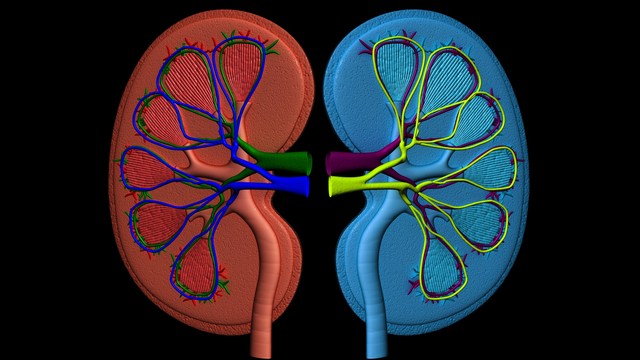IgA is a protein that is part of the immune system's defense against infection. In patients with IgA nephropathy, the protein forms deposits in the kidneys and interferes with their function.
According to the National Kidney and Urologic Diseases Information Clearinghouse (NKUDIC), about 25 percent of adults with IgA nephropathy will develop total kidney failure.
IgA nephropathy can develop at any age. Children who develop this illness have a 5-10 percent chance of developing total kidney failure. There are no symptoms in the early stages, and the disease may remain silent for years or even decades.
The first symptom is usually blood in the urine. The NKUDIC advises anyone who notices blood in the urine to see a doctor, but this symptom does not always indicate serious disease.
Heavy exercise can also cause blood in the urine. In more advanced cases of IgA nephropathy, protein can leak into the urine. The hands and feet may swell when protein levels in the urine rise too high.
After 10 to 20 years of IgA nephropathy, the patient may develop symptoms of kidney failure. These include nausea, fatigue, headaches, and sleep problems, as well as swelling in the hands and feet.
Blood tests and urine tests can be used to diagnose kidney disease. A biopsy can be used to identify IgA deposits in the kidneys, to make the diagnosis of IgA nephropathy.
Treatments include corticosteroids, omega-3 fatty acids, vitamin E, and control of blood pressure and cholesterol. The goal of treatment is to slow the progression of the disease and prevent complications. Once kidney damage occurs, it is usually irreversible.
A French group studied which patients are at high risk for kidney failure. Francois Berthoux and collegues wrote, “For the individual patient with primary IgA nephropathy (IgAN), it remains a challenge to predict long-term outcomes.”
Berthoux found three factors important for the prognosis:
1.High blood pressure
2.Protein in the urine, more than 1 gram per deciliter
3.Severe pathological lesions, as found in a kidney biopsy
In a study of 332 patients followed for 13 years, these factors had the strongest association with kidney failure resulting in either death or the need for dialysis.
“To our knowledge, we are the first to publish about the absolute renal risk of dialysis/death and to propose comprehensive scoring with an important clinical application,” Berthoux concluded.
The American Autoimmune Related Diseases Association offers more information on IgA nephropathy and other autoimmune diseases on its web page.
References:
National Kidney and Urologic Diseases Information Clearinghouse (NKUDIC), National Institutes of Health. IgA Nephropathy. Web. April 18, 2012.
http://kidney.niddk.nih.gov/kudiseases/pubs/iganephropathy
Berthoux F et al, “Predicting the risk for dialysis or death in IgA nephropathy”, J Am Soc Nephrol 2011; 22: 752-61. http://www.ncbi.nlm.nih.gov/pubmed/21258035
American Autoimmune Related Diseases Association. Patient Information. Web. April 18, 2012.
http://www.aarda.org/patient_information.php
Reviewed May 9, 2012
by Michele Blacksberg RN
Edited by Jody Smith





Add a CommentComments
There are no comments yet. Be the first one and get the conversation started!